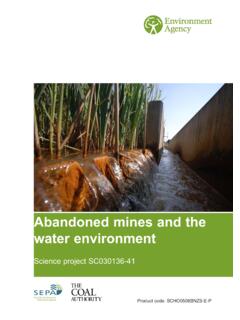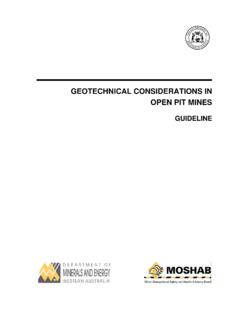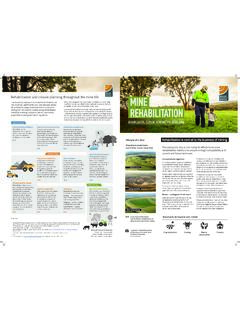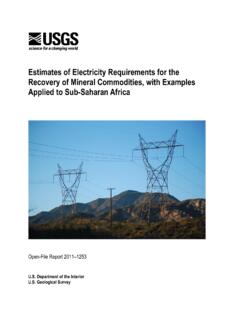Transcription of December 2021 Version: 2
1 Recognised Standard 21. Underground Explosion Barriers Coal Mining Safety and Health Act 1999. December 2021. Version: Resources Safety & Health Queensland 1 of 23. Recognised Standards may be updated from time to time. To ensure you have the latest version, check the RSHQ website: or contact your local Inspector of mines . Mineral mine and quarries (north Mineral mines and quarries (north Minerals mines and quarries region) west region) (south region). Townsville District Office Mt Isa Office Brisbane Office PO Box 1752 PO Box 334 PO Box 15216. Townsville Q 4810 Mount Isa Q 4825 City East Brisbane Q 4000. P (07) 4447 9248 P (07) 4745 4114 P (07) 3330 4272. Atherton Office Coal mines (south region) Coal mine (north region).
2 Rockhampton Regional Office Mackay Office PO Box 210 PO Box 3221 PO Box 1801. Atherton Q 4883 Red Hill Q 4701 Mackay Q 4740. P (07) 4095 7023 P (07) 4936 0184 P (07) 4999 8512. This publication has been compiled by Recognised Standard Sub-Committee 21. Members: Laurie Crisp, Bharath Belle, Michael King, Stephen Watts, Matthew Way, Gareth Kennedy, Les Marlborough, Andre De Kock, and Nathan Parsons. State of Queensland, 2021. The Queensland Government supports and encourages the dissemination and exchange of its information. The copyright in this publication is licensed under a Creative Commons Attribution International (CC BY ) licence. Under this licence you are free, without having to seek our permission, to use this publication in accordance with the licence terms.
3 You must keep intact the copyright notice and attribute the State of Queensland as the source of the publication. Note: Some content in this publication may have different licence terms as indicated. For more information on this licence, visit The information contained herein is subject to change without notice. The Queensland Government shall not be liable for technical or other errors or omissions contained herein. The reader/user accepts all risks and responsibility for losses, damages, costs and other consequences resulting directly or indirectly from using this information. Resources Safety & Health Queensland 2 of 23. Recognised Standards This document is issued in accordance with PART 5 RECOGNISED.
4 STANDARDS and Section 37(3) of the Coal Mining Safety and Health Act 1999. PART 5 - RECOGNISED STANDARDS. 71 Purpose of recognised standards A standard may be made for safety and health (a recognised standard ) stating ways to achieve an acceptable level of risk to persons arising out of coal mining operations. 72 Recognised standards (1) The Minister may make recognised standards. (2) The Minister must notify the making of a recognised standard by gazette notice. (3) The CEO must publish on a Queensland government website each recognised standard and any document applied, adopted or incorporated by the standard. (4) In this section - Queensland government website means a website with a URL that contains ', other than the website of a local government.
5 73 Use of recognised standards in proceedings A recognised standard is admissible in evidence in a proceeding if . (a) the proceeding relates to a contravention of a safety and health obligation imposed on a person under part 3; and (b) it is claimed that the person contravened the obligation by failing to achieve an acceptable level of risk; and (c) the recognised standard is about achieving an acceptable level of risk. PART 3- SAFETY AND HEALTH OBLIGATION. 37. How obligation can be discharged if regulation or recognised standard made 37(3) if a recognised standard states a way or ways of achieving an acceptable level of risk, a person discharges the person's safety and health obligation in relation to the risk only by.
6 (a) adopting and following a stated way; or (b) adopting and following another way that achieves a level of risk that is equal to or better than the acceptable level.. Where a part of a recognised standard or other normative document referred to therein conflicts with the Coal Mining Safety and Health Act 1999 or the Coal Mining Safety and Health Regulation 2017, the Act or Regulation takes precedence. This recognised standard is issued under the authority of the Minister for Resources. [Notified 17 December 2021]. Resources Safety & Health Queensland 3 of 23. Table of Contents 1 Purpose .. 5. 2 5. 3 Application framework .. 5. 4 Effective management and control of coal dust explosions.
7 6. 5 Technical guidance .. 7. 6 Explosion barriers Examples .. 8. 7 Barrier design parameters .. 8. General .. 8. Passive explosion barriers .. 8. Stone Dust (bagged barriers) .. 8. General types of stone dust bagged barriers .. 13. Advancing distributed 13. Concentrated barrier .. 16. Fixed distributed barrier .. 18. Active Barriers .. 20. 20. Installation .. 21. 8 Validation and 22. 9 References .. 23. 10 Acronyms .. 23. Table of Figures Figure 1 Bags suspended facing the direction of any blast waves .. 10. Figure 2 Typical barrier bag .. 10. Figure 3 Typical bag placement in a roadway between and m high .. 11. Figure 4 Typical bag placement suspended around a roadway obstruction.
8 12. Figure 5 Spacing of Individual 12. Figure 6 Distributed Barrier System .. 15. Figure 7 Concentrated Barrier System .. 17. Figure 8 Fixed Distributed Barrier System .. 19. Figure 9 Active barrier relevant 20. Figure 10 Homotropal maingate belt road active barrier installation example .. 21. Resources Safety & Health Queensland 4 of 23. 1 Purpose The purpose of this standard is to provide a technical standard for selection, installation, maintenance and use of explosion barriers in underground coal mine roadways, to assist in reducing the risk of propagation of an explosion to an acceptable level. This Recognised Standard does not reduce obligations to comply with stone dusting requirements as per Sections 300, 301,302 & 303 of the CMSHR 2017.
9 2 Scope This Recognised Standard applies to an explosion barrier constructed, installed and maintained in underground coal mines in the State of Queensland. Any active or passive barrier may be used that achieves a level of risk that is equal to or better than the level of risk achieved by the barriers mentioned within this Recognised Standard. A physical test, or a combination of a physical and a laboratory test must be carried out by an independent recognised testing facility to prove the barrier can effectively suppress a coal dust explosion. 3 Application framework A coal dust explosion is propagated by a failure to manage incombustible matter to a level that prevents this hazard eventuating.
10 This presents a significant hazard in an underground coal mine, and has the potential to propagate to every part of a mine resulting in multiple fatalities. Coal dust in suspension has flammable limits from approximately 35 g/m to 1000 g/m . There are various environmental factors that will influence these flammable limits. Coal dust explosions are usually a secondary explosion initiated by a methane explosion. The primary explosion creates shock waves that disperse coal dust into the air and the flame ignites the coal dust. These coal dust explosions are often self-propagating and extremely violent, affecting large sections of the mine. Additional defences are needed to prevent the propagation of the primary ignition into a coal dust explosion.










